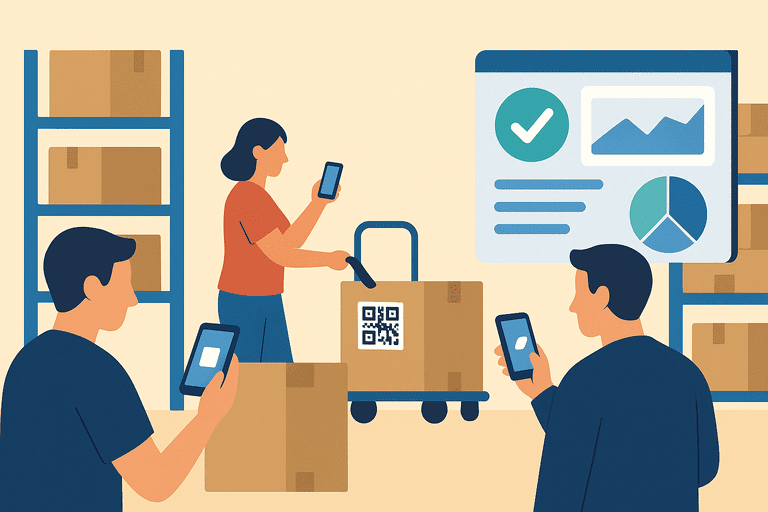Why Mobile Apps Are Essential for Modern Inventory Control
Discover why mobile apps are essential for modern inventory control. Learn how they boost accuracy, save time, and cut costs.

Introduction
Gone are the days when inventory control meant clipboards, spreadsheets, and long hours in the stockroom. Today, businesses need real-time, flexible, and accurate tracking to keep up with fast-moving operations.
That’s where mobile apps for inventory control come in. By turning smartphones into powerful scanning and reporting tools, businesses can simplify tracking, improve accountability, and cut costs.
This article explains why mobile apps are now essential for modern inventory management and how they can transform everyday operations.
The Problem with Traditional Inventory Control
Traditional methods rely on:
- Paper logs.
- Desktop-only software.
- Barcode scanners tethered to computers.
These approaches are slow, error-prone, and hard to scale.
Typical issues include:
- Staff delays when updating records.
- Data discrepancies between paper logs and reality.
- Expensive hardware (dedicated scanners).
- No visibility outside the office or warehouse.
Why Mobile Apps Are a Game-Changer
Smartphones are everywhere. With mobile apps:
- Employees can scan items instantly using built-in cameras.
- Updates sync directly to the cloud.
- Real-time data is available from anywhere.
- Training is easier since staff already know how to use phones.
Mobile-first solutions bring speed, accuracy, and accessibility to inventory control.
Key Benefits of Mobile Inventory Apps
1. Real-Time Updates
- Changes are synced immediately to the cloud.
- Managers always know the true status of stock or assets.
2. QR Code & Barcode Scanning
- Smartphones double as scanners — no need for extra devices.
- QR codes allow for rich data (e.g., maintenance logs, history).
3. Lower Costs
- Eliminates expensive hardware like handheld scanners.
- Many apps use existing employee phones.
4. Flexibility for Remote Work
- Perfect for hybrid teams or multiple locations.
- Track equipment across offices, warehouses, or coworking spaces.
5. Faster Audits
- Teams can scan assets in the field.
- Reports generated instantly.
6. Improved Accountability
- Every check-in/out tied to a user account.
- Reduced risk of items “disappearing.”
Example: IT Team with Mobile Tracking
A 60-person IT team managed laptops and monitors using spreadsheets. Audits took 3 weeks, and items frequently went missing.
After adopting a mobile app with QR code scanning:
- Audits took just 3 days.
- Missing equipment dropped by 70%.
- Staff checked out laptops instantly with their phones.
👉 Related: The True Cost of Manual Check-In/Out Systems.
Who Benefits Most from Mobile Inventory Apps?
- Small businesses — Affordable entry into digital inventory.
- Coworking spaces — Shared furniture and electronics tracked easily.
- Educational institutions — Students borrow laptops, lab tools, and instruments.
- Healthcare providers — Staff track consumables and medical devices.
- Construction & workshops — Tools and equipment constantly move.
How to Implement Mobile Inventory Control
Step 1: Choose an App
Select inventory software (like InvyMate) with mobile app support for QR/barcode scanning.
Step 2: Tag All Assets
Apply QR codes or barcodes to every item.
Step 3: Train Staff
Show how to scan items during check-in/out. Emphasize accountability.
Step 4: Sync with Cloud
Ensure all updates are real time. No more end-of-day manual uploads.
Step 5: Monitor Reports
Use mobile dashboards to spot low stock, overdue returns, or underused assets.
Best Practices
- Start with high-value or frequently borrowed items.
- Use durable labels for assets in heavy use.
- Train staff during onboarding to adopt scanning habits.
- Enable push notifications for low stock or overdue items.
- Run regular mobile audits to confirm accuracy.
Common Mistakes to Avoid
- Using mobile apps without proper training — adoption fails.
- Forgetting to tag small assets — cables and accessories add up.
- Not syncing with cloud — offline-only apps risk data loss.
- Overloading staff with unnecessary alerts.
Conclusion
Mobile apps have become essential tools for modern inventory control. They cut costs, speed up audits, and make real-time updates accessible from anywhere.
Instead of wasting hours on spreadsheets or relying on expensive scanners, businesses can empower their teams with tools they already carry: smartphones.
The result? Faster, smarter, and more accountable inventory management.
👉 Want to see how mobile apps can simplify your inventory control? Try InvyMate today — scan, track, and manage assets in real time with just your phone.